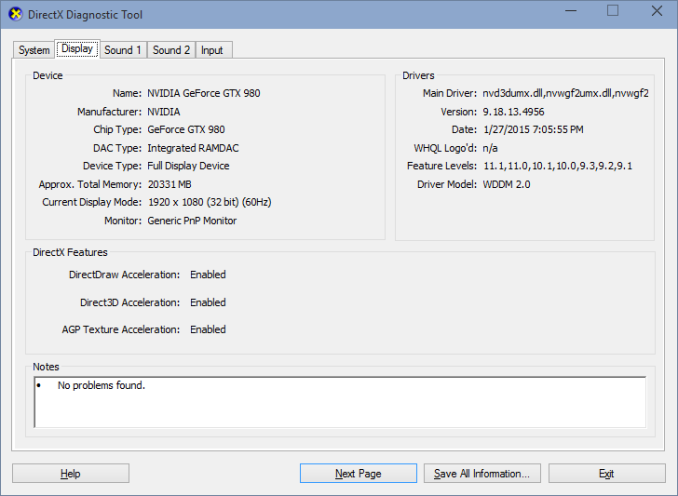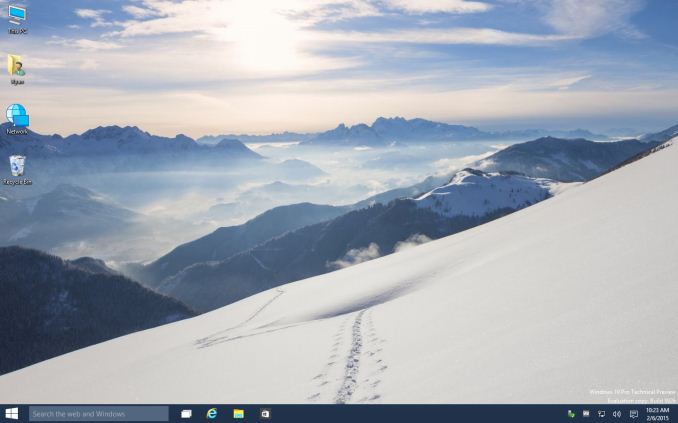The DirectX 12 Performance Preview: AMD, NVIDIA, & Star Swarm
by Ryan Smith on February 6, 2015 2:00 PM EST- Posted in
- GPUs
- AMD
- Microsoft
- NVIDIA
- DirectX 12
The Current State of DirectX 12 & WDDM 2.0
Although DirectX 12 is up and running in the latest public release of Windows 10, it and many of its related components are still under development. Windows 10 itself is still feature-incomplete, so what we’re looking at here today doesn’t even qualify as beta software. As a result today’s preview should be taken as just that: an early preview. There are still bugs, and performance and compatibility is subject to change. But as of now everything is far enough along that we can finally get a reasonable look at what DirectX 12 is capable of.
From a technical perspective the DirectX 12 API is just one part of a bigger picture. Like Microsoft’s last couple of DirectX 11 minor version upgrades, DirectX 12 goes hand-in-hand with a new version of the Windows Display Driver Model, WDDM 2.0. In fact WDDM 2.0 is the biggest change to WDDM since the driver model was introduced in Windows Vista, and as a result DirectX 12 itself represents a very large overhaul of the Windows GPU ecosystem.
Top: Radeon R9 290X. Bottom: GeForce GTX 980
Microsoft has not released too many details on WDDM 2.0 so far – more information will be released around GDC 2015 – but WDDM 2.0 is based around enabling DirectX 12, adding the necessary features to the kernel and display drivers in order to support the API above it. Among the features tied to WDDM 2.0 are DX12’s explicit memory management and dynamic resource indexing, both of which wouldn’t have been nearly as performant under WDDM 1.3. WDDM 2.0 is also responsible for some of the baser CPU efficiency optimizations in DX12, such as changes to how memory residency is handled and how DX12 applications can more explicitly control residence.
The overhauling of WDDM for 2.0 means that graphics drivers are impacted as well as the OS, and like Microsoft, NVIDIA and AMD have been preparing for WDDM 2.0 with updated graphics drivers. These drivers are still a work in progress, and as a result not all hardware support is enabled and not all bugs have been worked out.
| DirectX 12 Support Status | ||||
| Current Status | Supported At Launch | |||
| AMD GCN 1.2 (285) | Working | Yes | ||
| AMD GCN 1.1 (290/260 Series) | Working | Yes | ||
| AMD GCN 1.0 (7000/200 Series) | Buggy | Yes | ||
| NVIDIA Maxwell 2 (900 Series) | Working | Yes | ||
| NVIDIA Maxwell 1 (750 Series) | Working | Yes | ||
| NVIDIA Kepler (600/700 Series) | Working | Yes | ||
| NVIDIA Fermi (400/500 Series) | Not Active | Yes | ||
In short, among AMD and NVIDIA their latest products are up and running in WDDM 2.0, but not on all of their earlier products. In AMD’s case GCN 1.0 cards are supported under their WDDM 2.0 driver, but we are encountering texturing issues in Star Swarm that do not occur with GCN 1.1 and later. Meanwhile in NVIDIA’s case, as is common for NVIDIA beta drivers they only ship with support enabled for their newer GPUs – Kepler, Maxwell 1, and Maxwell 2 – with Fermi support disabled. Both AMD and NVIIDA have already committed to supporting DirectX 12 (and by extension WDDM 2.0) on GCN 1.0 and later and Fermi and later respectively, so while we can’t test these products today, they should be working by the time DirectX 12 ships.
Also absent for the moment is a definition for DirectX 12’s Feature Level 12_0 and DirectX 11’s 11_3. Separate from the low-level API itself, DirectX 12 and its high-level counterpart DirectX 11.3 will introduce new rendering features such as volume tiled resources and conservative rasterization. While all of the above listed video cards will support the DirectX 12 low-level API, only the very newest video cards will support FL 12_0, and consequently be fully DX12 compliant on both a feature and API basis. Like so many other aspects of DirectX 12, Microsoft is saving any discussion of feature levels for GDC, at which time we should find out what the final feature requirements will be and which (if any) current cards will fully support FL 12_0.
Finally, with Microsoft’s announcement of their Windows 10 plans last month, Microsoft is also finally clarifying their plans for the deployment of DirectX 12. Because DirectX 12 and WDDM 2.0 are tied at the hip, and by extension tied to Windows 10, DirectX 12 will only be available on Windows 10. Windows 8/8.1 and Windows 7 will not be receiving DirectX 12 support.
| DirectX 12 Supported OSes | ||||
| Will Support DX12? | Required WDDM Version | |||
| Windows 10 | Yes | 2.0 | ||
| Windows 8.1 | No | N/A | ||
| Windows 8 | No | N/A | ||
| Windows 7 | No | N/A | ||
Backporting DirectX 12 to earlier OSes would require backporting WDDM 2.0 as well, which brings with it several issues due to the fact that WDDM 2.0 is a kernel component. Microsoft would either have to compromise on WDDM 2.0 features in order to make it work on these older kernels, or alternatively would have to more radically overhaul these kernels to accommodate the full WDDM 2.0 feature set, the latter of which is a significant engineering task and carries a significant risk of breaking earlier Windows installations. Microsoft has already tried this once before in backporting parts of Direct3D 11.1 and WDDM 1.2 to Windows 7, only to discover that even that smaller-scale project had compatibility problems. A backport of DirectX 12 would in turn be even more problematic.
The bright side of all of this is that with Microsoft’s plans to offer Windows 10 as a free upgrade for Windows 7/8/8.1 users, the issue is largely rendered moot. Though DirectX 12 isn’t being backported, Windows users will instead be able to jump forward for free, so unlike Windows 8 this will not require spending money on a new OS just to gain access to the latest version of DirectX. This in turn is consistent with Microsoft’s overall plans to bring all Windows users up to Windows 10 rather than letting the market get fragmented among different Windows versions (and risk repeating another XP), so the revelation that DirectX 12 will not get backported has largely been expected since Microsoft’s Windows 10 announcement.
Meanwhile we won’t dwell on the subject too much, but DirectX 12 being limited to Windows 10 does open up a window of opportunity for Mantle and OpenGL Next. With Mantle already working on Windows 7/8 and OpenGL Next widely expected to be similarly portable, these APIs will be the only low-level APIs available to earlier Windows users.













245 Comments
View All Comments
eanazag - Monday, February 9, 2015 - link
Yes, and they need more millions of machines to attract developers. Find any app that exists on iOS, Android, and Windows and you'll see that the Windows version is usually lagging in support or features. Example: Star Wars Commander receives the same updates iOS does weeks later.They absolutely need developers to get on board. When they do, there should be a corresponding stream of cash flow in the Windows store.
Blessedman - Tuesday, February 10, 2015 - link
This is 100% correct... Ask any Machead if they would prefer Max Excel or Windows Excel, it is a clear choice that the windows version of Excel is far away a better product. When they can develop for an audience, do you think they would rather show off their product on the niche market (anything other than windows)?Blessedman - Tuesday, February 10, 2015 - link
Errr This isn't 100% correct.SparkySamza - Tuesday, February 10, 2015 - link
yes but numbers on mac vs mac excel, numbers wins every time cause numbers is a boss.Christopher1 - Monday, February 16, 2015 - link
True, but Windows 8 has the Store and it is a PAID upgrade from Vista and 7 so..... that comparison sorts falls flat in the real world.ymcpa - Saturday, February 7, 2015 - link
It's free only for the first year and it's not free to OEMs and large enterprise customers, who use software assurance anyways. They want everyone to upgrade to create a large enough user base to attract developers again. This will benefit windows tablets and phones and might make them competitive against ios and android. The only thing really holding tablets and phones back is the app selection. On the other hand, Google's only reason for giving away free software and service s to establish a large user so that the can sell ads to target that user base. In that scenario, you are the product.bitcrazed - Saturday, February 7, 2015 - link
"It's free only for the first year .."No. Win 10 is a free upgrade if you upgrade within a year of initial release. There is no fee to be paid after the 1st year.
Because we now live in a world where one doesn't need to replace one's machine every 3 years in order to be able to run the next OS version, Microsoft has learned that it needs to incentivize users to upgrade to newer OS' in order to prevent what happened with XP:
Although Microsoft had released Vista, 7 and 8, until fairly recently, a considerable percentage of their userbase were still running XP. Microsoft had to extend the support lifespan of XP twice to avoid leaving XP users without an upgrade path, but still they refused to upgrade. Then Microsoft could do no more and even extended support expired resulting in a larger number of upgrades from XP.
My offering Win10 as a free upgrade, Microsoft (and the entire industry) hopes to encourage users to upgrade from their current OS - XP, Vista, 7 or 8.x to the new OS sooner rather than later.
hwangeruk - Saturday, February 7, 2015 - link
Eh? His "free for the first year" comment was correct, stop splitting hairs.Microsoft is not trying to prevent what happened with XP at all, that's just wrong.
MS need apps for mobile, so wants a mass of users to get the tablet and phone space back.
They also want to win some hearts and minds as Windows 8 had a mixed reception (even though after 8.1 updates it was fine, the damage was done. Like games with launch issues sometimes don't recover from negative early reviews)
This has 0 to do with XP, and the XP extended support for only for paying customers not generally consumers. This move has 0 to do with XP, you are so wrong on that.
zodiacfml - Sunday, February 8, 2015 - link
It is free. They put it for free for the first year of the OS so that people are forced to upgrade immediately and not any amount of time longer than that as it that defeats the purpose of putting a huge percentage of people into just one, current operating system.Besides, adopters would be will beta testers with little obligation from MS.
Wwhat - Sunday, February 8, 2015 - link
But what does windows10 desktop to do with getting the tablet and phone space? And what do you mean with "get the tablet and phone space back", back? MS never had that market ever, nor is MS likely to get it.But yes, they are likely hoping to gain from 'an appstore' and 'cloud' and the always listening and handy for advertisers and security services alike voice-command thing.
All of which exemplifies the reason to worry..